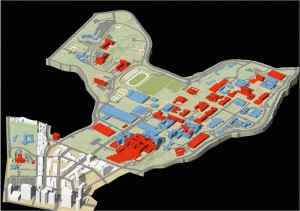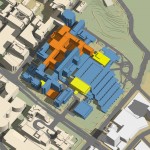Peter Hendrickson began his career in seismic restoration in the midst of one of the most damaging earthquakes to rock Southern California in recent memory: the 1994 Northridge earthquake.
Now, the UCLA associate vice chancellor of design and construction heads the decades long Seismic Correction Program, a $2.2 billion program for renovating and reconstructing UCLA-owned buildings to bring them up to seismic safety codes.
A recent Los Angeles Times article highlighted the issue, pointing out more than 1,000 seismically unsafe buildings in Los Angeles, including a UCLA owned office building in Westwood.
University officials began targeting specific buildings in and around UCLA during the 1970s and 1980s, after the 1971 Fillmore earthquake – an event which engineers and architects deemed “seismically deficient.”
Hendrickson said the university found 66 buildings, including Powell Library, Royce Hall, Glorya Kaufman Hall and the old hospital, in need of structural repair after the destructive earthquake.
The day the Northridge earthquake hit, UCLA was already a decade into its restoration of Powell Library.
Of the 66 buildings in poor seismic structure, 49 have been restored to seismic code so far.
 [media-credit name=”Center for the Health Sciences” align=”aligncenter” width=”300″]
[media-credit name=”Center for the Health Sciences” align=”aligncenter” width=”300″]
UCLA began the Seismic Correction Program in the mid-1980s and plans to complete the project in 2019 – in time for UCLA’s centennial year.
The funding for the project comes from philanthropy, long-term financing, research grants to individual departments and state grants, said William Coleman, the assistant director of capital planning and finance.
He added that while the older buildings are beautiful and historic, they were built in a different time with different seismic regulations.
While there may be damage to a restored building after a seismic event, the program’s main goal is to save each building from total collapse in the event of an earthquake and make each building secure enough for people to exit.
“We need a structurally safe environment,” Hendrickson said.
Hendrickson pointed to the recent South Tower project in the Center for Health Sciences as an example of the constrained perimeters that UCLA architects must plan around.
Hendrickson said the remaining buildings in need of restoration or renovation are the Center for Health Sciences, a UCLA Extension center, Clark Library, Parking Structure 5 and the West Campus Cooling Plant.
As program leaders developed intensive plans that targeted different sections of campus, they found each corner of UCLA presented engineers and architects with different issues in restoring the seismic safety of the building.
Jeffrey Averill, a campus architect in capital programs, design and construction, said engineers carefully consider the advantages and disadvantages in demolishing an entire building over a potential renovation.
“Earthquake engineering is not so much an exact science (as) an art,” Averill said.
Because UCLA is confined by Westwood and the surrounding residential areas, the university cannot expand and build new structures in other areas, Averill added.
Engineers usually choose to renovate buildings, instead of demolishing them, because it is more cost efficient and sustainable to repair older buildings, he said.
“Engineers want to give new life to older buildings; that’s our first choice,” Averill said.
One of the buildings engineers chose to repurpose was the old atomic era hospital, Hendrickson said.
Engineers originally planned to demolish the entire hospital, but later found that the layout of the outdated building can provide an optimal space for current research needs because of its long and linear construction and abundance of natural light, Hendrickson said.
“It has a very appropriate configuration for 21st century research,” Hendrickson said.
UCLA planners have also had to develop the retrofit strategy partially depending on different levels of seismic code, which correspond to different buildings at UCLA, Hendrickson said.
Essential service buildings, like the Ronald Reagan UCLA Medical Center and police stations, must withstand the shock of a categorized major event while remaining functional after the event, Hendrickson said. But, educational buildings, like Powell Library and the Humanities building, do not need to follow as stringent of code.
Though multiple factors make quantifying the potential damage of a seismic event difficult for engineers to predict, Averill and Hedrickson said they still consider the project a way to build on past techniques and develop new strategies to make every building at UCLA safe.
